Navigation
Install the app
How to install the app on iOS
Follow along with the video below to see how to install our site as a web app on your home screen.
Note: This feature may not be available in some browsers.
More options
Style variation
You are using an out of date browser. It may not display this or other websites correctly.
You should upgrade or use an alternative browser.
You should upgrade or use an alternative browser.
Why do pads turn color?
- Thread starter NiSyam
- Start date
shoeless89
New member
- Jul 18, 2010
- 1,985
- 0
Unless you are polishing single stage paint, the only real COLOR on the pad should be the color of the compound/polish. If your getting the color of the paint on the pad that's different from the color of the compound you either A) are polishing single stage paint or B) have burnt through the clear coat somehow and are now down the the base coat.
The only other thing I can think of would be you didn't decontaminate the clay using a claybar or something similar and are picking up the color of the contaminates. Which would be VERY bad
Sent from my DROID Pro using Tapatalk
The only other thing I can think of would be you didn't decontaminate the clay using a claybar or something similar and are picking up the color of the contaminates. Which would be VERY bad
Sent from my DROID Pro using Tapatalk
Joe@Superior Shine
New member
- Jun 25, 2009
- 1,073
- 0
Re: Why do pads turn
There are a few reasons why a pad would change color on the portion that actually touches the finish. The most common is that your polishing a single stage paint system. If your "pulling color" the finish isn't topped with a clear coat.
There are a few reasons why a pad would change color on the portion that actually touches the finish. The most common is that your polishing a single stage paint system. If your "pulling color" the finish isn't topped with a clear coat.
Joe@Superior Shine
New member
- Jun 25, 2009
- 1,073
- 0
Re: Why do pads turn
Most vehicles are clear coat/base coat but not all. Toyota / Lexus black is single stage for example as well as lots of commercial vehicles.
Most vehicles are clear coat/base coat but not all. Toyota / Lexus black is single stage for example as well as lots of commercial vehicles.
kronos
New member
- Jul 7, 2009
- 1,408
- 0
Re: Why do pads turn
Another reason pads will turn black during polishing is because during the claying and decontamination process, some grime occupying the lower half of panels may have been missed causing the grime to transfer to the pad's face. I have personally experienced this.
Another reason pads will turn black during polishing is because during the claying and decontamination process, some grime occupying the lower half of panels may have been missed causing the grime to transfer to the pad's face. I have personally experienced this.
Bunky
Well-known member
- Jun 20, 2007
- 6,408
- 137
Re: Why do pads turn
That is very likely. If a car has never been detailed before (clay or used a paint cleaner), the pad can get very dirty looking quickly. There is a lot of embedded grime on the paint and this is what affects paint clarity.
Another reason pads will turn black during polishing is because during the claying and decontamination process, some grime occupying the lower half of panels may have been missed causing the grime to transfer to the pad's face. I have personally experienced this.
That is very likely. If a car has never been detailed before (clay or used a paint cleaner), the pad can get very dirty looking quickly. There is a lot of embedded grime on the paint and this is what affects paint clarity.
Setec Astronomy
Well-known member
- Aug 31, 2010
- 16,838
- 1,167
Re: Why do pads turn
So in this case it appears the vehicle in question had single-stage paint. But for anyone else reading this, it should be noted that it could also be the other reasons mentioned above; removal of embedded dirt in the paint, contact with rubber trim, etc.
Some of the newer clears are "tintcoats" which are tinted clears that will color the pad. One of the more common ones is a red that GM uses. These are usually extra-cost paints.
Black when you polish a black car? If you are only removing clear coat which is clear why does the pad turn black?
So in this case it appears the vehicle in question had single-stage paint. But for anyone else reading this, it should be noted that it could also be the other reasons mentioned above; removal of embedded dirt in the paint, contact with rubber trim, etc.
Would a pad turn blue if you polish a blue car? yellow if the car is yellow?
Some of the newer clears are "tintcoats" which are tinted clears that will color the pad. One of the more common ones is a red that GM uses. These are usually extra-cost paints.
Re: Why do pads turn
:iagree:
Bill
I agree with the posts above. Your pad turns black because the paint is single stage paint. Another reason no one has mentioned yet is when you hit any rubber trim. Your pad will turn black in a hurry.
:iagree:
Bill
HighLine
New member
- Nov 19, 2011
- 34
- 0
That is very likely. If a car has never been detailed before (clay or used a paint cleaner), the pad can get very dirty looking quickly. There is a lot of embedded grime on the paint and this is what affects paint clarity.
Agree
Mike Phillips
Active member
- Dec 5, 2022
- 51,004
- 6
Re: Why do pads turn
Single Stage Paint
If you're pulling a LOT of color or pigment then the car is a single stage paint like this 1957 Chevy we buffed out just a few weeks ago...
1957 Chevrolet Bel Air - Remove Swirls - Modeled by Kristin
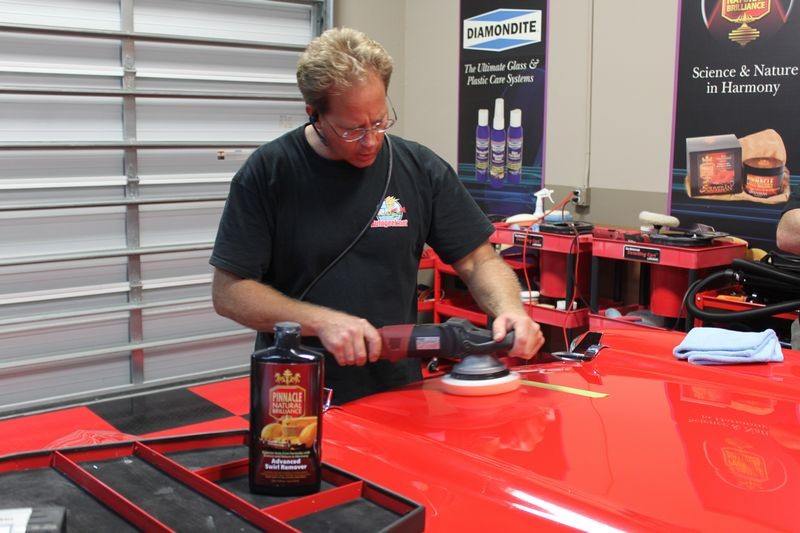
Yep... we're working on red single stage paint as you can see by the red pigment transferring to the face of the buffing pad.

You can see the red pigment building up on the pad as PJ buffs a vertical panel.
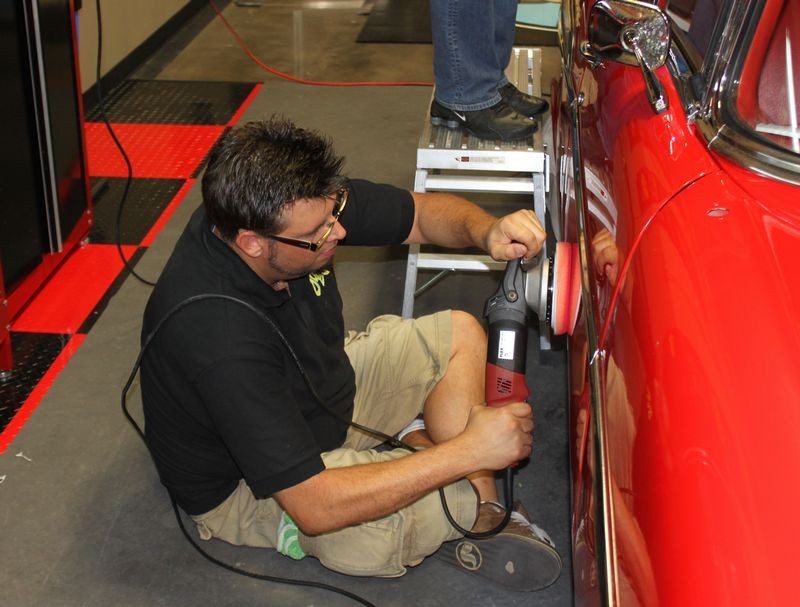
Here you can see red pigment on the face of some of the buffing pads we used on the 1957 Chevy...
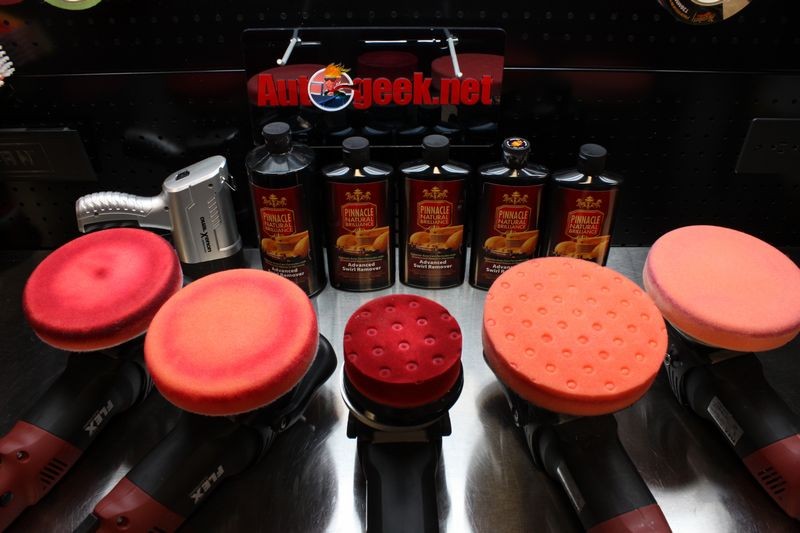
And you can really see the red pigment on this white terry cloth towel after doing some pad cleaning...
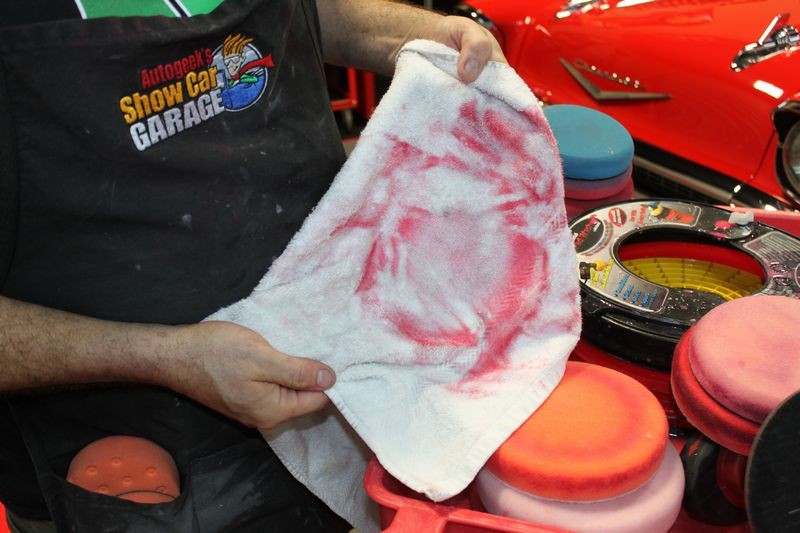
Finished...
One thing about single stage paints, correctly polished you get amazing richness of color, gloss and depth...

Tinted Clear Coats
If you're working on a TINTED clear you'll pull a LITTLE color or pigment and see this on your buffing pad. For example, here's some pictures from the Red Jewel Tint 2011 Camaro we buffed out a few weeks ago that belongs to Rene.
2011 Camaro - Modeled by Amy
Robert does a Test Spot on the hood to dial-in the process the rest of us will duplicate over the rest of the car. For this he's using the Flex 3401 with a Cyan Hydro-Tech Cutting Pad and the Blackfire Scratch Resistant Compound. This combination of products on the 5.0 Speed Setting removed all but the deepest RIDS
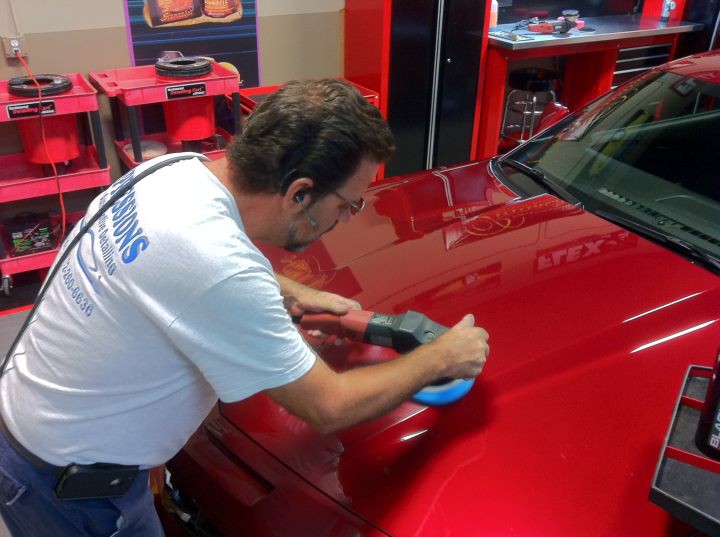
Here you can see the tint in the tinted clear coming off the car as we compound it and onto the face of the pad. This is nothing to worry about, keep in mind when you're doing any correction work on a clearcoat paint system you too are removing paint that is building up on the face of your buffing pad but because the paint is clear you won't see it build-up on the face of your pad.
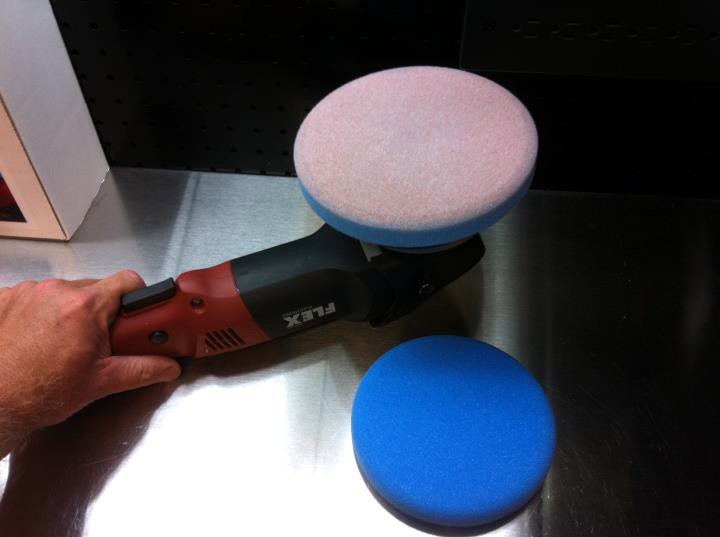
See this article,
Why it's important to clean your pads often...
Finished...
Polished correctly, tinted clears offer a candied look...

Clear Coat Paint
If you're working on a clear coat paint the only color you should see on the pad is the color of the compound, polish or wax you're using.
When we buffed out the 1977 Can Am Corvette we used Optimum Hyper-Compound which is blue on a blue pad on a clear coated black car and never pulled any color during our buffing process.
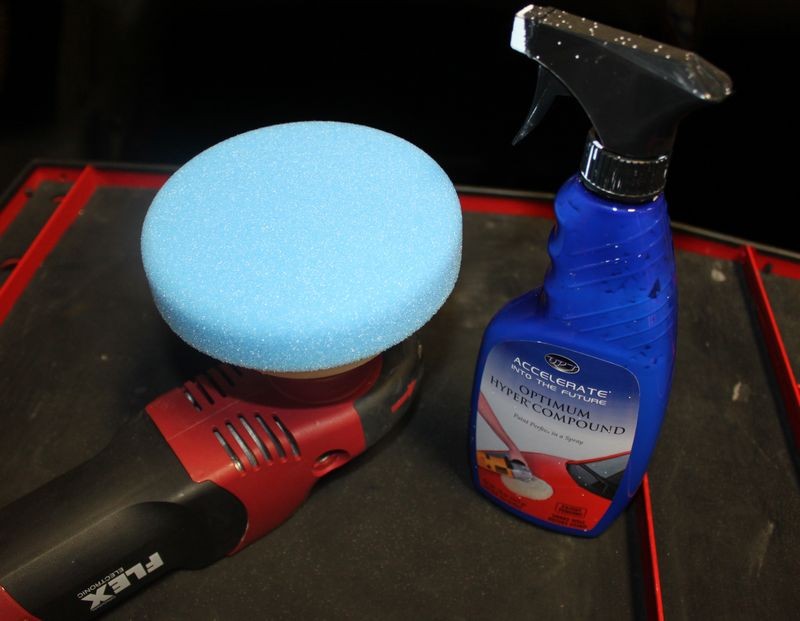

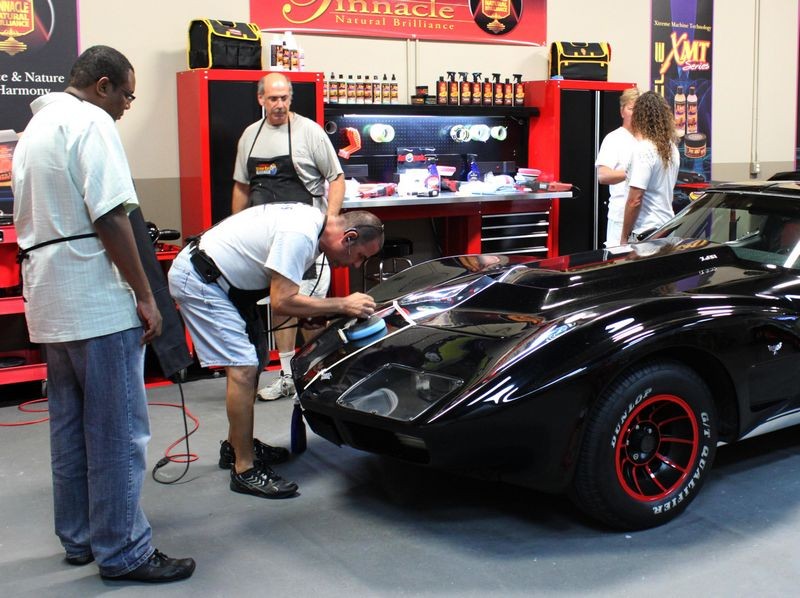
No color coming off the car and onto the pad...
Anytime you're working on a clear coat the only color you want to see on your buffing pad is the color of the pad and the color of the compound, polish or wax. If you see the color of the paint... that's a bad thing... a real bad thing...
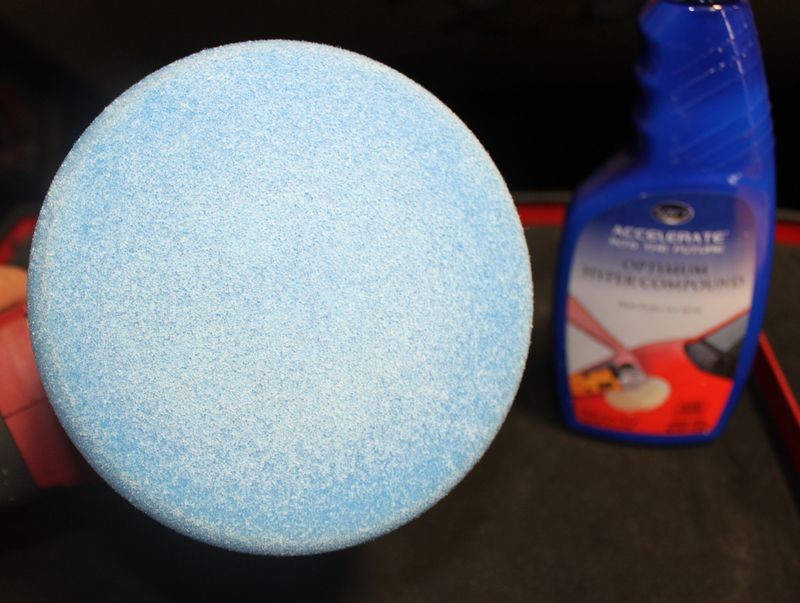
Finished...
Polished correctly a clear coat will be perfectly clear and showcase the color of the basecoat...

Embedded Dirt In Paint...
It's possible to be working on a clear coated car and see a brownish, grayish, blackish tinge or tint on your buffing pad even after washing and claying the paint. If you see this it's a sign of staining of the paint which is dirt in the air or some type of contaminant embedded on the paint and in the paint from the environment in where the car is stored, driven or parked.
1954 Ford F-100 - Extreme Makeover - Process and products used
We wiped this "Show Truck" down with DP Waterless Wash and then clayed each panel, this effectively would have removed any loose dirt or dust and bonded contaminants.
Restoring smoothness by claying the paint
Here's Glen the owner of the truck claying just in front of the windshield for the very first time..
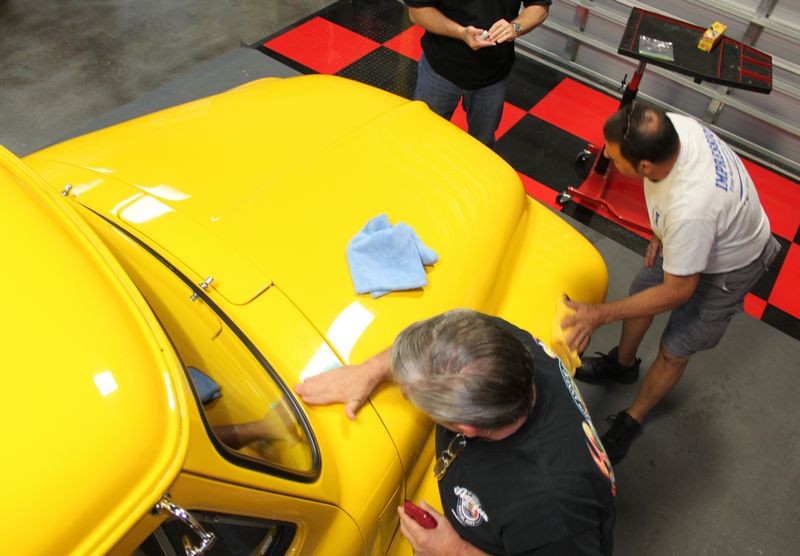
Here's Jeff claying the back of the truck...
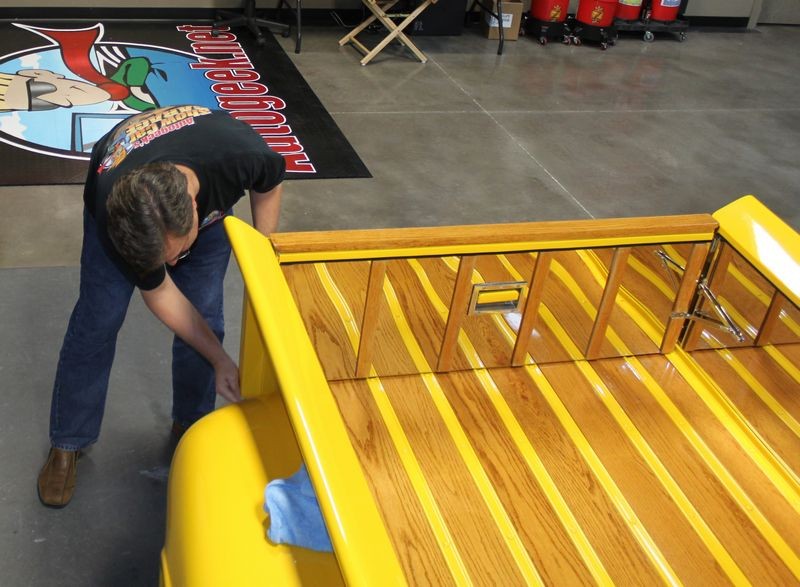
Rene claying the bed rails...

Glen, Adam and Rene claying the paint... you can already see the gloss becoming amped up just from claying...

Here's Robert and Glen tackling the roof, not they are standing on stable work platforms to protect both themselves and the truck.
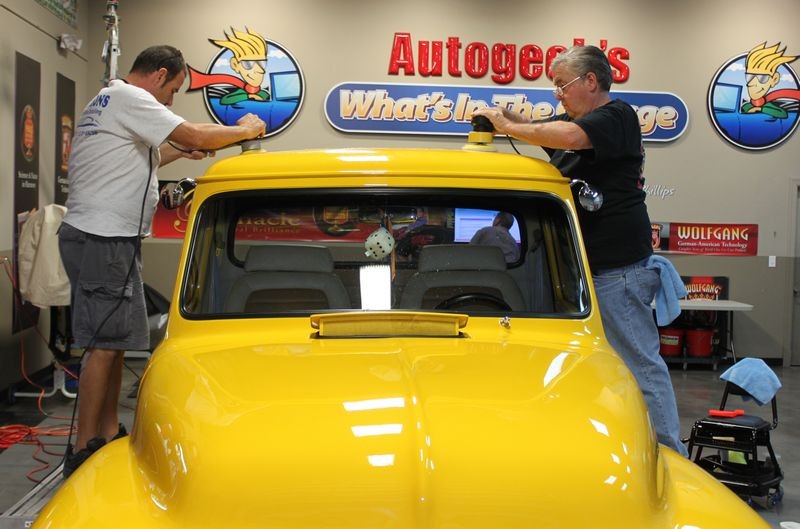
Robert using the PC and Glenn using the Meguiar's G110v2

Remember how dirty the clay was after claying just one half of the roof? Clay remove ABOVE surface bonded contaminants but it doesn't remove embedded staining of the paint. You can see abrading the paint with a light polish and a microfiber pad has removed the staining effect and restored a very bright and shiny finish.
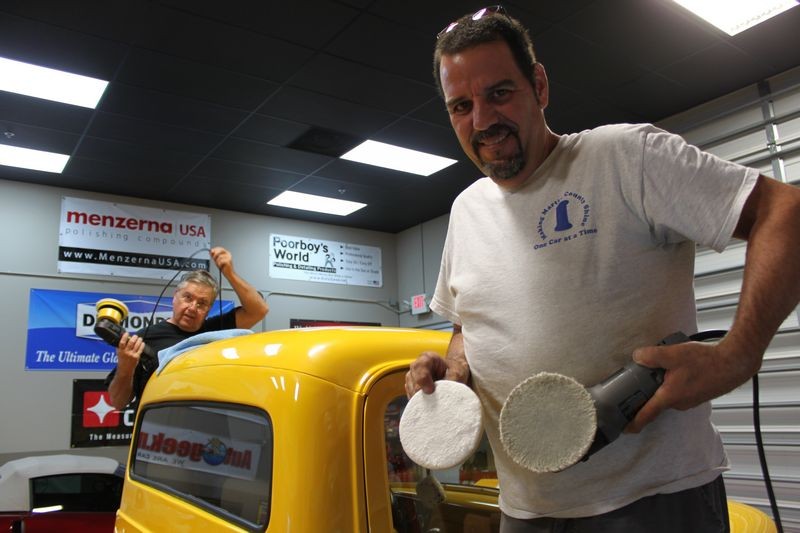
The pad on the left is new and bright white, the pad on the left is a grayish tinge to it from embedded dirt that was removed during the polishing process.

Finished...
Polished correctly, any swirls, scratches and embedded dirt will be removed and a totally clear and smooth finish produced...
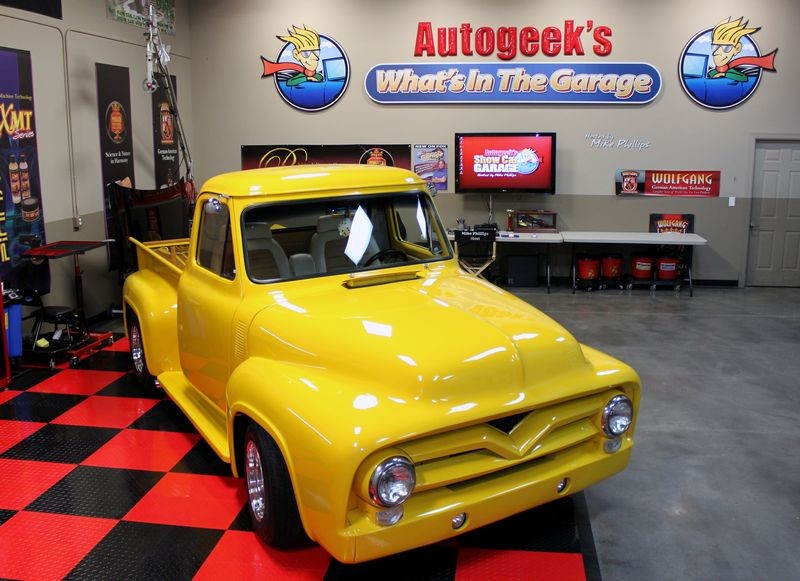
How to test for single stage paint, tinted clears and basecoat/clearcoat paint systems
I also cover how to test for single stage, tinted clears or basecoat/clear paints on page 10 and 11 in my how to book.
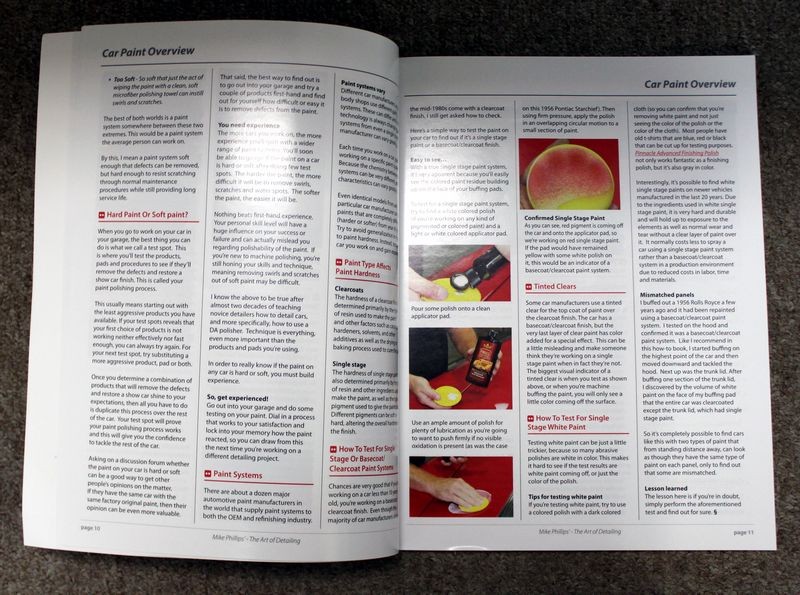


Single Stage Paint
If you're pulling a LOT of color or pigment then the car is a single stage paint like this 1957 Chevy we buffed out just a few weeks ago...
1957 Chevrolet Bel Air - Remove Swirls - Modeled by Kristin

Yep... we're working on red single stage paint as you can see by the red pigment transferring to the face of the buffing pad.

You can see the red pigment building up on the pad as PJ buffs a vertical panel.

Here you can see red pigment on the face of some of the buffing pads we used on the 1957 Chevy...

And you can really see the red pigment on this white terry cloth towel after doing some pad cleaning...

Finished...
One thing about single stage paints, correctly polished you get amazing richness of color, gloss and depth...

Tinted Clear Coats
If you're working on a TINTED clear you'll pull a LITTLE color or pigment and see this on your buffing pad. For example, here's some pictures from the Red Jewel Tint 2011 Camaro we buffed out a few weeks ago that belongs to Rene.
2011 Camaro - Modeled by Amy
Robert does a Test Spot on the hood to dial-in the process the rest of us will duplicate over the rest of the car. For this he's using the Flex 3401 with a Cyan Hydro-Tech Cutting Pad and the Blackfire Scratch Resistant Compound. This combination of products on the 5.0 Speed Setting removed all but the deepest RIDS

Here you can see the tint in the tinted clear coming off the car as we compound it and onto the face of the pad. This is nothing to worry about, keep in mind when you're doing any correction work on a clearcoat paint system you too are removing paint that is building up on the face of your buffing pad but because the paint is clear you won't see it build-up on the face of your pad.

See this article,
Why it's important to clean your pads often...
Finished...
Polished correctly, tinted clears offer a candied look...

Clear Coat Paint
If you're working on a clear coat paint the only color you should see on the pad is the color of the compound, polish or wax you're using.
When we buffed out the 1977 Can Am Corvette we used Optimum Hyper-Compound which is blue on a blue pad on a clear coated black car and never pulled any color during our buffing process.



No color coming off the car and onto the pad...
Anytime you're working on a clear coat the only color you want to see on your buffing pad is the color of the pad and the color of the compound, polish or wax. If you see the color of the paint... that's a bad thing... a real bad thing...

Finished...
Polished correctly a clear coat will be perfectly clear and showcase the color of the basecoat...

Embedded Dirt In Paint...
It's possible to be working on a clear coated car and see a brownish, grayish, blackish tinge or tint on your buffing pad even after washing and claying the paint. If you see this it's a sign of staining of the paint which is dirt in the air or some type of contaminant embedded on the paint and in the paint from the environment in where the car is stored, driven or parked.
1954 Ford F-100 - Extreme Makeover - Process and products used
We wiped this "Show Truck" down with DP Waterless Wash and then clayed each panel, this effectively would have removed any loose dirt or dust and bonded contaminants.
Restoring smoothness by claying the paint
Here's Glen the owner of the truck claying just in front of the windshield for the very first time..

Here's Jeff claying the back of the truck...

Rene claying the bed rails...

Glen, Adam and Rene claying the paint... you can already see the gloss becoming amped up just from claying...

Here's Robert and Glen tackling the roof, not they are standing on stable work platforms to protect both themselves and the truck.

Robert using the PC and Glenn using the Meguiar's G110v2

Remember how dirty the clay was after claying just one half of the roof? Clay remove ABOVE surface bonded contaminants but it doesn't remove embedded staining of the paint. You can see abrading the paint with a light polish and a microfiber pad has removed the staining effect and restored a very bright and shiny finish.

The pad on the left is new and bright white, the pad on the left is a grayish tinge to it from embedded dirt that was removed during the polishing process.

Finished...
Polished correctly, any swirls, scratches and embedded dirt will be removed and a totally clear and smooth finish produced...

How to test for single stage paint, tinted clears and basecoat/clearcoat paint systems
I also cover how to test for single stage, tinted clears or basecoat/clear paints on page 10 and 11 in my how to book.


Re: Why do pads turn
Ok, another question for this thread. I just hand polished a panel on my 2011 Lexus IS, and I can see some staining of the microfiber the same color as my paint, but I'm not believing Lexus doesn't have a clearcoat. Anyone? I used a really light black tinted polish, and I didn't push hard whatsoever.
Ok, another question for this thread. I just hand polished a panel on my 2011 Lexus IS, and I can see some staining of the microfiber the same color as my paint, but I'm not believing Lexus doesn't have a clearcoat. Anyone? I used a really light black tinted polish, and I didn't push hard whatsoever.